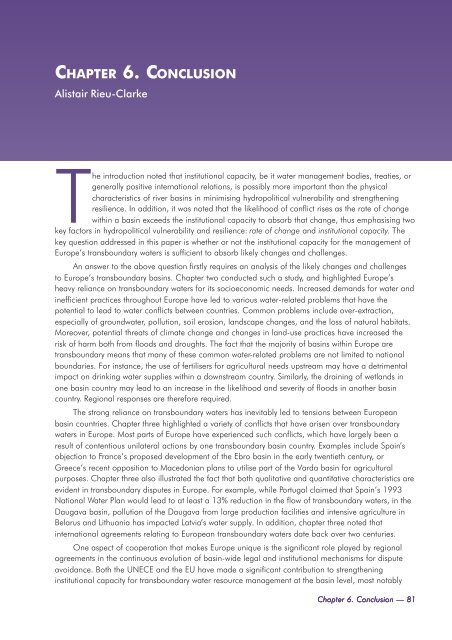Europe - UNEP
Europe - UNEP
Europe - UNEP
You also want an ePaper? Increase the reach of your titles
YUMPU automatically turns print PDFs into web optimized ePapers that Google loves.
CHAPTER 6. CONCLUSION<br />
Alistair Rieu-Clarke<br />
The introduction noted that institutional capacity, be it water management bodies, treaties, or<br />
generally positive international relations, is possibly more important than the physical<br />
characteristics of river basins in minimising hydropolitical vulnerability and strengthening<br />
resilience. In addition, it was noted that the likelihood of conflict rises as the rate of change<br />
within a basin exceeds the institutional capacity to absorb that change, thus emphasising two<br />
key factors in hydropolitical vulnerability and resilience: rate of change and institutional capacity. The<br />
key question addressed in this paper is whether or not the institutional capacity for the management of<br />
<strong>Europe</strong>’s transboundary waters is sufficient to absorb likely changes and challenges.<br />
An answer to the above question firstly requires an analysis of the likely changes and challenges<br />
to <strong>Europe</strong>’s transboundary basins. Chapter two conducted such a study, and highlighted <strong>Europe</strong>’s<br />
heavy reliance on transboundary waters for its socioeconomic needs. Increased demands for water and<br />
inefficient practices throughout <strong>Europe</strong> have led to various water-related problems that have the<br />
potential to lead to water conflicts between countries. Common problems include over-extraction,<br />
especially of groundwater, pollution, soil erosion, landscape changes, and the loss of natural habitats.<br />
Moreover, potential threats of climate change and changes in land-use practices have increased the<br />
risk of harm both from floods and droughts. The fact that the majority of basins within <strong>Europe</strong> are<br />
transboundary means that many of these common water-related problems are not limited to national<br />
boundaries. For instance, the use of fertilisers for agricultural needs upstream may have a detrimental<br />
impact on drinking water supplies within a downstream country. Similarly, the draining of wetlands in<br />
one basin country may lead to an increase in the likelihood and severity of floods in another basin<br />
country. Regional responses are therefore required.<br />
The strong reliance on transboundary waters has inevitably led to tensions between <strong>Europe</strong>an<br />
basin countries. Chapter three highlighted a variety of conflicts that have arisen over transboundary<br />
waters in <strong>Europe</strong>. Most parts of <strong>Europe</strong> have experienced such conflicts, which have largely been a<br />
result of contentious unilateral actions by one transboundary basin country. Examples include Spain’s<br />
objection to France’s proposed development of the Ebro basin in the early twentieth century, or<br />
Greece’s recent opposition to Macedonian plans to utilise part of the Varda basin for agricultural<br />
purposes. Chapter three also illustrated the fact that both qualitative and quantitative characteristics are<br />
evident in transboundary disputes in <strong>Europe</strong>. For example, while Portugal claimed that Spain’s 1993<br />
National Water Plan would lead to at least a 13% reduction in the flow of transboundary waters, in the<br />
Daugava basin, pollution of the Daugava from large production facilities and intensive agriculture in<br />
Belarus and Lithuania has impacted Latvia’s water supply. In addition, chapter three noted that<br />
international agreements relating to <strong>Europe</strong>an transboundary waters date back over two centuries.<br />
One aspect of cooperation that makes <strong>Europe</strong> unique is the significant role played by regional<br />
agreements in the continuous evolution of basin-wide legal and institutional mechanisms for dispute<br />
avoidance. Both the UNECE and the EU have made a significant contribution to strengthening<br />
institutional capacity for transboundary water resource management at the basin level, most notably<br />
Chapter 6. Conclusion — 81
















